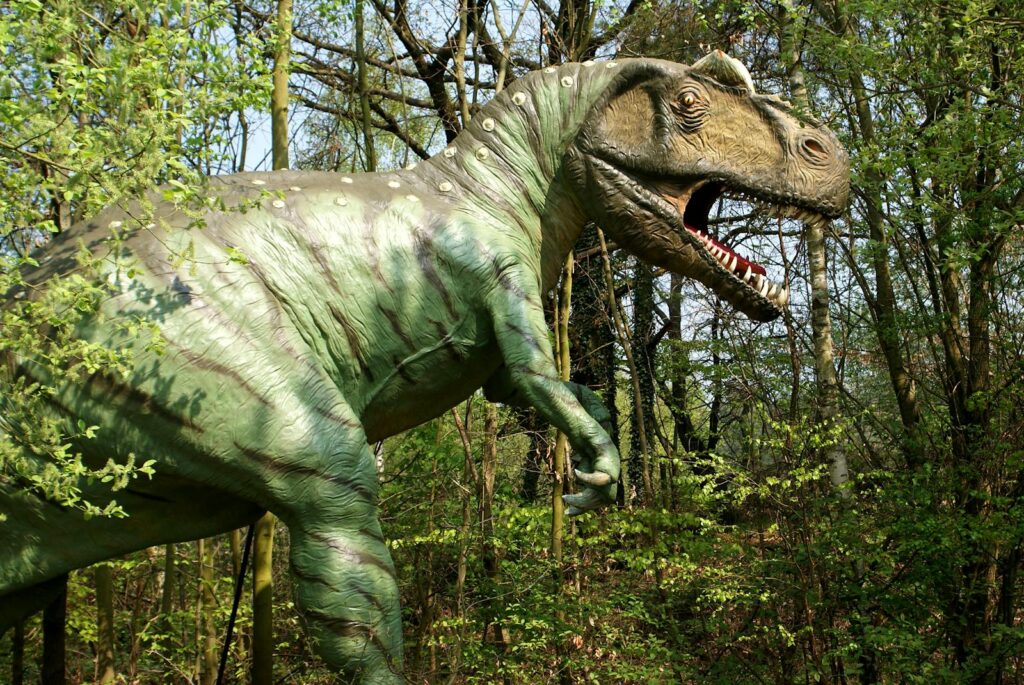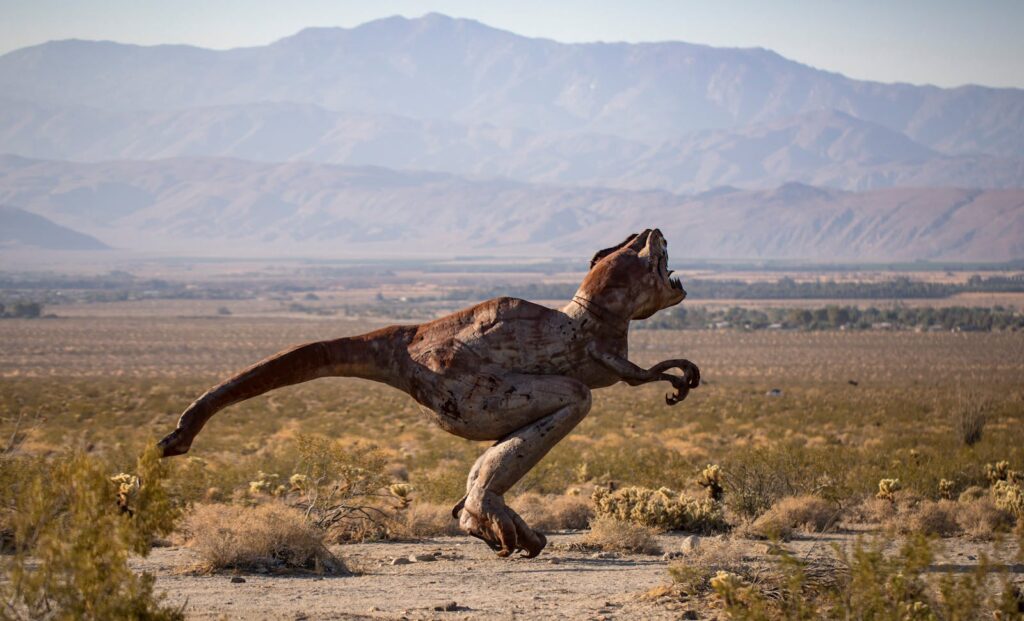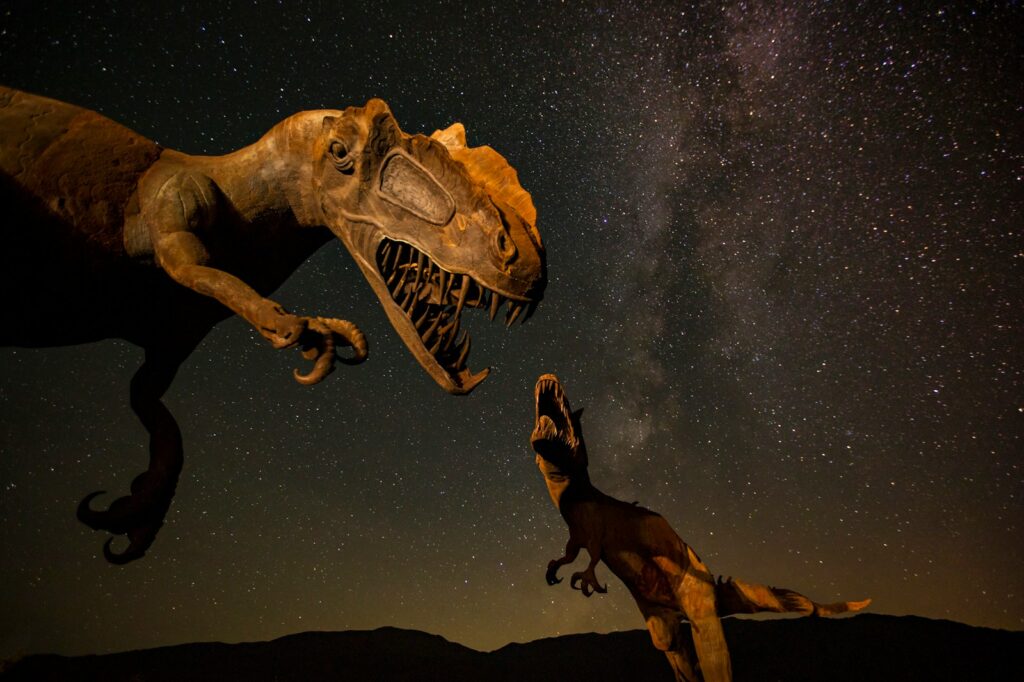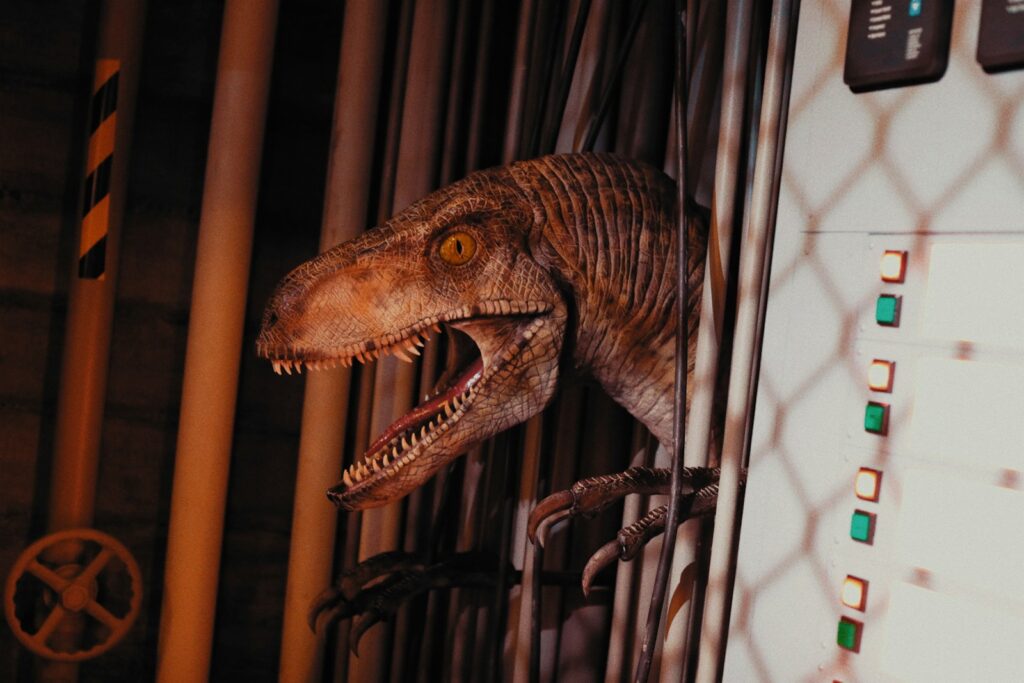From the thunderous footsteps of “Jurassic Park” to the feathered raptors of more recent productions, Hollywood has profoundly shaped our collective imagination of dinosaurs. These prehistoric creatures, extinct for over 65 million years, have been resurrected through special effects, artistic interpretation, and varying degrees of scientific accuracy.
The entertainment industry’s portrayal of dinosaurs has not only influenced public perception but has also enjoyed a complex relationship with paleontological research, sometimes reflecting scientific advances and other times prioritizing spectacle over accuracy.
This article explores how cinema has transformed our mental image of dinosaurs and the fascinating interplay between scientific discovery and cinematic imagination.
The Early Days: Dinosaurs as Movie Monsters

When dinosaurs first stomped onto the silver screen in the early 20th century, they bore little resemblance to what paleontologists understood about these ancient creatures. The 1925 film “The Lost World,” based on Arthur Conan Doyle’s novel, featured stop-motion dinosaurs created by Willis O’Brien that were revolutionary for their time but depicted dinosaurs as lumbering, aggressive monsters.
These early portrayals established dinosaurs as symbols of primordial terror rather than as animals that once inhabited Earth. Films like “King Kong” (1933) continued this tradition, showing dinosaurs as bloodthirsty beasts that existed primarily to create dramatic confrontations with the protagonists.
The scientific understanding of dinosaurs during this era was still developing, but filmmakers were more interested in creating memorable monsters than adhering to paleontological accuracy. These early films cemented the popular image of dinosaurs as reptilian behemoths with dragging tails and sluggish movements—a misconception that would persist for decades.
Disney’s “Fantasia” and the Shift Toward Naturalism

A significant evolution in dinosaur portrayal came with Disney’s 1940 masterpiece “Fantasia,” particularly in the “Rite of Spring” sequence that depicted Earth’s prehistoric era. While still not completely accurate by today’s standards, “Fantasia” marked an important shift toward showing dinosaurs as actual animals rather than movie monsters. The film portrayed dinosaurs in naturalistic settings, going about the business of finding food, raising young, and surviving in a harsh environment.
The famous Tyrannosaurus rex versus Stegosaurus battle (despite these species living millions of years apart) was framed as a predator-prey relationship rather than mindless monster combat. Disney’s animators consulted with paleontologist Barnum Brown from the American Museum of Natural History to incorporate contemporary scientific knowledge.
Although the dinosaurs still dragged their tails and moved slowly, “Fantasia” helped transition dinosaur portrayals from pure fantasy toward more scientifically informed depictions, setting the stage for greater accuracy in later decades.
The Dinosaur Renaissance in Scientific Thinking

The 1960s and 1970s witnessed a revolutionary shift in paleontological understanding dubbed the “Dinosaur Renaissance.” Led by scientists like John Ostrom and Robert Bakker, this movement challenged the traditional view of dinosaurs as sluggish, cold-blooded reptiles. New evidence suggested many dinosaurs were active, possibly warm-blooded creatures with sophisticated behaviors.
Bakker’s influential 1986 book “The Dinosaur Heresies” popularized the image of dinosaurs as dynamic, intelligent animals more similar to birds than to crocodiles. This scientific revolution had a delayed but profound impact on Hollywood depictions. Films began slowly incorporating these new ideas, though often selectively. The shift was visible in documentaries first, with productions like PBS’s “Nova” featuring updated dinosaur reconstructions.
This renaissance in scientific thinking eventually paved the way for the most influential dinosaur movie of all time—one that would forever change how the public envisioned these prehistoric creatures. The gap between scientific understanding and popular depiction was narrowing, though Hollywood would continue to take significant creative liberties.
Jurassic Park: The Watershed Moment

Steven Spielberg’s 1993 blockbuster “Jurassic Park” represents the single most influential portrayal of dinosaurs in popular culture. Based on Michael Crichton’s novel, the film leveraged groundbreaking CGI technology and practical effects to create dinosaurs that moved with unprecedented realism and dynamism.
Working with paleontological consultants, Spielberg’s team incorporated many contemporary scientific understandings, showing dinosaurs as agile, intelligent animals rather than lumbering monsters. The Velociraptors in particular, depicted as cunning pack hunters capable of problem-solving, revolutionized public perception of dinosaur intelligence.
The film’s portrayal of a swift, nimble Tyrannosaurus rex contradicted the slow-moving behemoth of earlier films. “Jurassic Park” also embedded scientific concepts in popular consciousness through memorable dialogue, such as Dr. Alan Grant’s discussion of the bird-dinosaur connection.
Despite some scientific inaccuracies and exaggerations for dramatic effect, the film raised the bar for realism in dinosaur depictions and sparked widespread public interest in paleontology, inspiring a generation of future scientists.
The Missing Feathers: Hollywood’s Resistance to Change

Perhaps the most significant disconnect between scientific understanding and Hollywood portrayal in recent decades concerns feathers. Since the 1990s, fossil evidence has conclusively demonstrated that many theropod dinosaurs, including Velociraptors and their relatives, possessed feathery coverings. This discovery strengthened the evolutionary connection between dinosaurs and birds, radically changing scientific reconstructions.
However, Hollywood has shown remarkable resistance to this evolutionary reality. The “Jurassic Park/World” franchise, despite producing several films after these discoveries, continued to depict raptors and other theropods as scaly rather than feathered. When “Jurassic World” director Colin Trevorrow was questioned about this discrepancy, he suggested that audiences expected consistency with earlier films rather than scientific accuracy.
This deliberate choice to prioritize established visual iconography over scientific fidelity exemplifies how commercial considerations often trump educational value in mainstream dinosaur media. The feather controversy highlights the tension between scientific advancement and the entertainment industry’s attachment to marketable, familiar dinosaur designs.
Size and Sound: Hollywood’s Supersizing Effect

One of Hollywood’s most persistent tendencies is exaggerating dinosaur proportions and vocalizations for dramatic effect. Filmmakers routinely depict dinosaurs as larger than their actual fossil record indicates, with the Velociraptor representing perhaps the most famous example. Real Velociraptors stood roughly knee-high to an adult human, more turkey-sized than the six-foot predators shown in “Jurassic Park.”
The film acknowledged this discrepancy by suggesting the cinematic raptors were actually Deinonychus, but kept the more dramatic name. Similarly, dinosaur sounds in films are entirely speculative and designed for emotional impact rather than accuracy. The iconic Tyrannosaurus rex roar from “Jurassic Park” was created by combining tiger, alligator, and elephant sounds—a choice made for theatrical effect rather than scientific plausibility.
Paleontologists suggest many dinosaurs likely made sounds more similar to birds or crocodilians than the mammalian-influenced roars heard in movies. These exaggerations, while scientifically problematic, have become deeply ingrained in the public imagination and continue to influence how we visualize prehistoric life.
Dinosaurs as Villains: The Persistent Monster Trope

Despite advances in scientific understanding, Hollywood frequently reverts to portraying dinosaurs as villainous monsters rather than as animals following natural behaviors. This is particularly evident in the later “Jurassic World” films, where dinosaurs like the Indominus rex and Indoraptor are explicitly designed as intelligent antagonists with seemingly malevolent intent.
Even natural dinosaurs in these films often display unrealistic aggression, pursuing humans relentlessly beyond what would be ecologically plausible for predatory animals. This tendency reflects cinema’s need for clear threats and dramatic tension rather than biological realism. Real predators typically avoid unnecessary confrontation and rarely attack without hunger or perceived threat as motivation.
The persistent monster trope undermines public understanding of dinosaurs as animals that operated within ecological contexts rather than as movie monsters bent on human destruction. Even in documentaries like “Walking with Dinosaurs,” dramatic confrontations are often overemphasized compared to the more mundane aspects of dinosaur existence that likely dominated their actual lives.
Documentary Influence: “Walking with Dinosaurs” and Beyond

The groundbreaking 1999 BBC documentary series “Walking with Dinosaurs” marked a significant evolution in dinosaur portrayals, presenting prehistoric creatures in the format of a nature documentary. Using cutting-edge computer animation and animatronics, the series attempted to show dinosaurs as animals within ecosystems rather than as isolated monsters.
This approach significantly influenced both public perception and subsequent media representations. The documentary format allowed for more nuanced portrayals of dinosaur behavior, including mating rituals, migration, and parent-offspring relationships that rarely feature in action-oriented films. “Walking with Dinosaurs” also made greater efforts to incorporate contemporary paleontological knowledge, though it still contained speculative elements.
The program’s success inspired numerous similar documentaries, including Discovery’s “Dinosaur Planet” and “Prehistoric Planet” on Apple TV+, each updating visual representations to reflect evolving scientific understanding. These documentary productions often achieve greater scientific accuracy than their theatrical counterparts, though they still employ dramatic license and speculation to create compelling narratives about creatures known only from fossil remains.
Animation’s Greater Freedom: Dinosaur Portrayals in Children’s Media

Animated films and television shows aimed at children have often demonstrated greater flexibility in updating dinosaur portrayals than live-action productions. Films like Pixar’s “The Good Dinosaur” and series such as PBS’s “Dinosaur Train” have incorporated feathered dinosaurs and other scientifically accurate details more readily than blockbuster franchises.
The cartoon medium, with its inherent stylization, allows creators to balance scientific accuracy with character design in ways that don’t alienate audiences. “Dinosaur Train” in particular has been praised by paleontologists for its commitment to educational content, introducing young viewers to lesser-known dinosaur species and accurate paleontological concepts while maintaining entertainment value.
Disney’s animated film “Dinosaur” (2000) attempted to create photo-realistic dinosaurs in naturalistic settings, though still taking creative liberties with their behavior and social structures. These children’s productions play a crucial role in shaping early perceptions of dinosaurs for each new generation, often providing more scientifically informed portrayals than the action-oriented blockbusters that capture older audiences.
The Influence of Merchandise and Marketing

The commercial aspects of dinosaur franchises have significantly shaped how these creatures are visually rendered and marketed to the public. The need for recognizable, toyetic designs has often overridden scientific accuracy in major film productions. The consistent appearance of dinosaurs across movie sequels, toys, video games, and theme park attractions creates powerful financial incentives to maintain established designs rather than update them to reflect new scientific discoveries.
When “Jurassic World” was in development, the financial stakes involved in changing the established, marketable dinosaur designs to include scientifically accurate features like feathers were deemed too high. The recognizable “Jurassic” aesthetic has become a valuable intellectual property that transcends scientific considerations.
This commercial reality extends beyond major franchises; dinosaur representations in everything from children’s backpacks to bedsheets tend to recycle familiar visual tropes rather than incorporate evolving scientific understanding. The merchandising ecosystem around dinosaurs thus creates a conservatism in visual representation that slows the incorporation of new paleontological findings into popular culture.
The Scientific Feedback Loop: When Movies Influence Research

The relationship between Hollywood and paleontology is not unidirectional but rather creates a fascinating feedback loop where popular media sometimes influences the direction of scientific inquiry. The enormous popularity of “Jurassic Park” generated widespread public interest in dinosaurs, leading to increased funding for paleontological research and inspiring many young people to pursue careers in the field.
Several prominent paleontologists have cited the film as their initial inspiration for studying dinosaurs. Beyond funding and recruitment, movie portrayals have occasionally prompted scientists to investigate specific questions about dinosaur biology and behavior. After “Jurassic Park” popularized the idea of Velociraptor pack hunting, paleontologists devoted more attention to studying evidence of social behavior in theropod dinosaurs.
Similarly, cinematic depictions of dinosaur vocalizations have inspired research into the sound-producing capabilities of various species. This cross-pollination between entertainment and science demonstrates how even scientifically flawed portrayals can ultimately contribute to advancing our understanding of prehistoric life by generating interest and inspiring specific research questions.
Recent Trends: Are Hollywood Dinosaurs Getting More Accurate?

Recent years have shown some promising signs of greater scientific accuracy in dinosaur media, though progress remains uneven across different productions. Apple TV+’s “Prehistoric Planet” (2022), produced in collaboration with the BBC and narrated by David Attenborough, represents perhaps the most scientifically updated visualization of dinosaurs in a major production, featuring accurately feathered theropods and incorporating current paleontological theories about behavior and ecology.
Even the “Jurassic World” franchise has made modest concessions to scientific accuracy, with “Jurassic World Dominion” (2022) including some partially feathered dinosaurs for the first time in the series. Independent and lower-budget productions often demonstrate greater freedom to incorporate scientific advancements, as seen in films like “The Valley of Gwangi” and various dinosaur documentaries on streaming platforms.
However, commercial pressures and audience expectations continue to constrain major studio productions, which still frequently prioritize spectacle and familiar designs over scientific fidelity. The tension between entertainment value and educational accuracy remains, though digital technologies now make it increasingly feasible to create dinosaurs that are both scientifically informed and visually compelling.
The Future of Dinosaurs on Screen

As both paleontological knowledge and visual effects technology continue to advance, the future of dinosaur portrayals in media stands at a fascinating crossroads. Emerging technologies like virtual reality and augmented reality offer new possibilities for immersive, scientifically accurate dinosaur experiences that weren’t possible in traditional film formats.
These technologies could potentially bridge the gap between entertainment and education more effectively than conventional movies. Meanwhile, the growing availability of streaming platforms has created opportunities for more specialized dinosaur content aimed at niche audiences interested in scientific accuracy, alongside mainstream productions that continue to prioritize spectacle. Paleontologists are increasingly involved in media productions as consultants, though their influence on final designs varies considerably between projects.
The recent success of more scientifically informed productions like “Prehistoric Planet” suggests there may be a viable audience for accurate dinosaur portrayals, potentially influencing future Hollywood productions to incorporate more current science. Whatever direction future dinosaur media takes, the dynamic relationship between scientific discovery and cinematic imagination will continue to shape how we envision these magnificent creatures from Earth’s distant past.
Conclusion

The evolution of dinosaur portrayals in Hollywood reflects the complex interplay between scientific discovery, artistic imagination, and commercial imperatives. From the simplistic monster movies of the early 20th century to today’s sophisticated digital creations, our cinematic dinosaurs have undergone remarkable transformations that both reflect and sometimes diverge from our growing paleontological understanding.
While inaccuracies and exaggerations persist, the general trend has moved toward more scientifically informed representations, especially in documentary formats. Hollywood’s dinosaurs have profoundly shaped public perception of these ancient creatures, sometimes impeding scientific literacy but also generating widespread fascination with paleontology.
As both science and filmmaking technology continue to advance, the gap between what researchers understand about dinosaurs and what appears on our screens may continue to narrow, offering future generations increasingly realistic glimpses into Earth’s prehistoric past.




